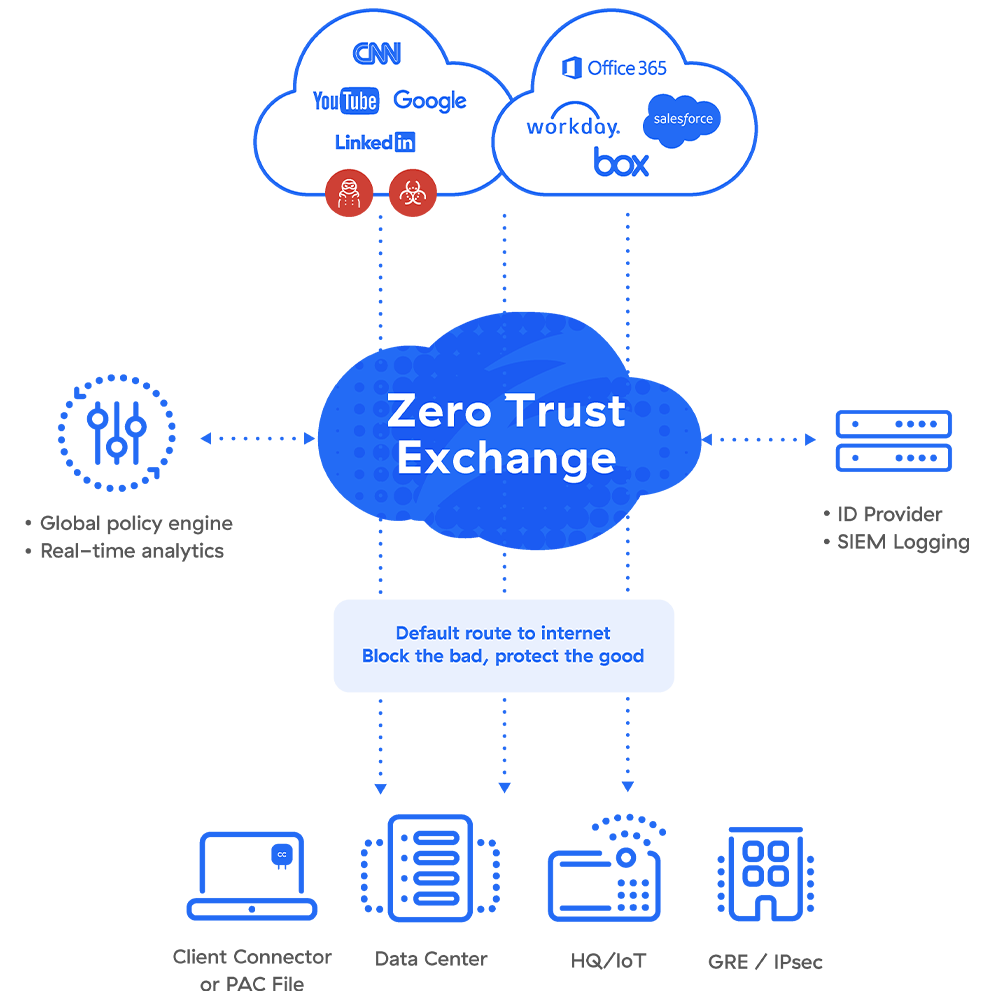/ Qu’est-ce que la sécurité du Web ?
Qu’est-ce que la sécurité du Web ?

Sécurité du Web vs. Sécurité des applications Web
Avant d’aller plus loin, clarifions ces termes. La sécurité du Web peut également inclure la sécurité des applications Web (également appelée sécurité des sites Web), une sous-catégorie de pratiques et d’outils qui contribuent à sécuriser les sites Web grand public. Dans le cadre de cet article, nous nous concentrerons spécifiquement sur les solutions de sécurité du Web qui sécurisent les serveurs ou les terminaux des utilisateurs, ainsi que le trafic qui circule entre eux et Internet.
Quel est l’objectif de la sécurité du Web ?
En raison de l’importance considérable d’Internet pour les entreprises modernes et de l’augmentation connexe de la sophistication, de la fréquence et de l’impact des cyberattaques, la sécurité du Web est devenue essentielle à la continuité des activités. Elle constitue votre première ligne de défense contre les menaces susceptibles d’exposer vos données sensibles, d’entraîner des rançons coûteuses, de nuire à votre réputation, de provoquer des violations de la conformité et de causer bien d’autres préjudices.
Autrefois réservées aux petits hackers, les menaces véhiculées par Internet ont évolué vers un gigantesque marché parallèle qui touche le monde du crime organisé, de l’espionnage et du sabotage d’État. Certaines des dernières menaces sont incroyablement sophistiquées, capables de tromper facilement les observateurs non avertis ou de contourner les systèmes de sécurité en place. De plus, avec un éventail d’outils prêts à l’emploi, de kits d’exploitation, de modules JavaScript et même de campagnes entièrement développées disponibles à la vente, même un acteur novice peut aisément lancer une attaque.
Cybersecurity Ventures estime que, d’ici 2025, la cybercriminalité mondiale coûtera 10,5 milliers de milliards de dollars par an (un bénéfice supérieur à celui du principal commerce illicite de drogues dans le monde) et que la moitié des données du monde se trouveront dans le cloud. Compte tenu de l’enjeu, il est facile de comprendre pourquoi une sécurité du Web efficace est si importante aujourd’hui.
Quels sont les avantages de la sécurité du Web ?
Pour une entreprise moderne, une sécurité du Web efficace présente de larges avantages techniques et humains :
- Protéger votre entreprise et maintenir sa conformité en évitant la perte de données sensibles
- Protéger les clients et les employés en sécurisant leurs informations privées
- Éviter les interruptions de service coûteuses en prévenant les infections et les exploits
- Offrir une meilleure expérience utilisateur en contribuant à la sécurité et à la productivité de vos utilisateurs
- Conserver la fidélité et la confiance des clients en restant en sécurité et en évitant de faire la une des journaux
Les grandes avancées de la technologie du cloud et de la mobilité permettent à vos employés et clients de se connecter à vous avec une facilité et une flexibilité sans précédent. Malheureusement, cela va dans les deux sens, et les hackers disposent de plus de moyens d’approcher la surface d’attaque élargie de votre entreprise. Avec les bonnes protections Web en place, vous pouvez passer plus de temps à exploiter vos bénéfices, et moins à vous inquiéter des menaces de sécurité.
De quoi la sécurité du Web protège-t-elle ?
La sécurité du Web couvre un large champ de protection des utilisateurs et des terminaux contre les e-mails malveillants, les menaces chiffrées, les sites Web et bases de données malveillants ou compromis, les redirections malveillantes, les détournements d’identité, etc. Examinons plus en détail quelques-unes des menaces les plus courantes :
- Ransomware : ces attaques chiffrent les données, puis exigent le paiement d’une rançon en échange d’une clé de déchiffrement. Dans une attaque à double extorsion, vos données sont également exfiltrées.
- Programmes malveillants généraux : il existe d’innombrables variantes de programmes malveillants qui sont susceptibles d’induire des fuites de données, de l’espionnage, des accès non autorisés, des blocages, des erreurs et des pannes de système.
- Hameçonnage : souvent menées par le biais d’e-mails, de SMS ou de sites Web malveillants, ces attaques incitent les utilisateurs à divulguer des informations d’identification ou à télécharger des logiciels espions.
- Injection SQL : ces attaques exploitent une vulnérabilité d’entrée dans un serveur de base de données, permettant à un hacker d’exécuter des commandes qui lui permettent de récupérer, manipuler ou supprimer des données.
- Déni de service (DoS) : ces attaques ralentissent ou même mettent à l’arrêt un périphérique réseau tel qu’un serveur en lui envoyant plus de données qu’il ne peut en traiter. Dans le cas d’une attaque DoS distribuée, c’est-à-dire une attaque DDoS, celle-ci est exécutée par de nombreux dispositifs détournés en même temps.
- Cross-site scripting (XSS) : dans ce type d’attaque par injection, un hacker introduit un code malveillant sur un site Web de confiance en le saisissant dans un champ de saisie utilisateur non protégé.
La solution de sécurité du Web idéale exploite plusieurs technologies afin de stopper les programmes malveillants et les ransomwares, de bloquer les domaines d’hameçonnage, de restreindre l’utilisation des informations d’identification, et plus encore, en construisant une défense globale.
Examinons un peu plus en détail comment cela fonctionne.
Comment fonctionne la sécurité du Web ?
Les fonctions de sécurité du Web se situent entre les terminaux de votre environnement et Internet. De là, elles inspectent le trafic et les requêtes voyageant dans les deux sens. Aucune technologie unique ne surveille ou n’inspecte l’ensemble du trafic, mais une « pile » d’appliances, ou une plateforme de services fournie dans le cloud, plus efficace aujourd’hui, offre une protection globale pour prévenir les violations de politiques, les infections causées par des logiciels malveillants, la perte de données, le vol d’identifiants, etc.
De nombreuses solutions sont disponibles aujourd’hui, certaines plus complètes que d’autres. Dans une pile complète, la sécurité du Web inclut les technologies suivantes :
- Passerelle Web sécurisée (SWG) : fournit une protection contre les menaces et une application des politiques destinées aux utilisateurs accédant au Web afin de prévenir les infections et de bloquer le trafic indésirable.
- Pare-feu/IPS : assure la sécurité du réseau, le contrôle des applications et la visibilité. Les pare-feu cloud restent à jour et évoluent en fonction de la demande ou du chiffrement, ce qui en fait une option plus pratique.
- Filtrage des URL : permet de filtrer et de bloquer les accès ou les contenus inappropriés, offrant également une protection contre les programmes malveillants véhiculés par le Web.
- Sandboxing : isole les logiciels dans un environnement où ils peuvent être analysés et exécutés sans risque d’infecter un système ou d’autres applications.
- Isolation du navigateur : charge les pages Web ou les applications dans un navigateur distant et n’envoie que les pixels de l’utilisateur, empêchant ainsi le téléchargement, la copie, le collage et l’impression de données ou de documents.
- Contrôles DNS : ils définissent des règles qui contrôlent les demandes et les réponses liées au trafic DNS, vous permettant de détecter et d’empêcher les abus DNS tels que le tunneling.
- Antivirus : détecte et neutralise les chevaux de Troie, les logiciels espions, les ransomwares, et plus encore. De nombreuses offres protègent également contre les menaces telles que les URL malveillantes, l’hameçonnage et le DDoS.
- Déchiffrement TLS/SSL : décompose le trafic chiffré entrant et sortant pour inspecter son contenu, puis le rechiffre pour qu’il poursuive sa route vers sa destination.

L’argument en faveur de la sécurité du Web dans le cloud
En tant que matériel sur site, les technologies de sécurité du Web sont hébergées dans une appliance SWG dans votre centre de données. Votre pile matérielle peut inclure des pare-feu, des filtres URL et DNS, des appliances de sandboxing et bien d’autres afin de protéger toutes les fonctions.
Le problème avec une approche basée sur le matériel est celui des inévitables lacunes. Les appliances nécessitent des correctifs permanents pour vous protéger des attaques de type zero-day, et si les correctifs tardent, vous vous exposez à des vulnérabilités exploitables. Les appliances sont également limitées en termes de performances, en particulier lorsqu’il s’agit de trafic chiffré TLS/SSL, qui constitue la quasi-totalité du trafic actuel, ce qui signifie qu’elles ne peuvent pas éliminer de manière satisfaisante les menaces cachées.
En outre, beaucoup trop d’appareils (souvent du même fournisseur) ne communiquent pas entre eux, de sorte que la corrélation des données entre eux est extrêmement difficile, même pour des professionnels de la sécurité de l’information hautement qualifiés.
En revanche, une passerelle Web sécurisée fournie sous forme de service cloud offre une protection contre les menaces et une application des politiques en temps réel, empêchant l’accès aux sites Web infectés, même lorsque vos utilisateurs se trouvent en dehors de votre réseau d’entreprise, et bloquant l’entrée du trafic infecté ou indésirable sur votre réseau interne.
Comment Zscaler peut vous aider
La passerelle Web sécurisée de Zscaler (Secure Web Gateway) est entièrement fournie dans le cloud, de sorte qu’elle applique les politiques de sécurité de manière cohérente, quel que soit l’emplacement où les utilisateurs se connectent, les terminaux qu’ils utilisent ou l’endroit où les applications sont hébergées. Étant construite sur une architecture de cloud multi-entité globale pour une évolutivité maximale, elle peut inspecter tout le trafic chiffré sans dégradation des performances. De plus, notre plateforme intégrée cloud native réduit considérablement la complexité et les coûts de vos opérations par rapport à une approche matérielle.
Produits Zscaler pour la sécurité du Web
Bien plus qu’un simple service de sécurité, Zscaler Internet Access™ comprend un pare-feu cloud/IPS, le sandboxing, le filtrage des URL, l’isolation du navigateur cloud, la protection contre la perte de données (DLP), un Cloud Access Security Broker (CASB) et la gestion de la posture de sécurité cloud (CSPM) pour offrir une sécurité Internet sans faille à tous vos utilisateurs, sur le réseau et en dehors de celui-ci.
Zscaler a été nommé leader au sein du Carré Magique Gartner des passerelles Web sécurisées pendant 10 années consécutives. En 2021, Gartner a défini le Security Service Edge (une nouvelle catégorie qui inclut le SWG) et a par la suite désigné Zscaler comme Leader du Carré Magique Gartner 2022 pour le Security Service Edge, avec la meilleure « capacité d’exécution ».

